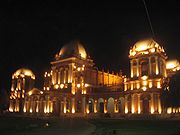
Noor Mahal
Encyclopedia

Bahawalpur
Bahawalpur , located in the province of Punjab, is the twelfth largest city in Pakistan. The city was once the capital of the former princely state of Bahawalpur. The city was home to various Nawabs and counted as part of the Rajputana states...
, Pakistan
Pakistan
Pakistan , officially the Islamic Republic of Pakistan is a sovereign state in South Asia. It has a coastline along the Arabian Sea and the Gulf of Oman in the south and is bordered by Afghanistan and Iran in the west, India in the east and China in the far northeast. In the north, Tajikistan...
. It was built in 1872 like an Italian chateau
Château
A château is a manor house or residence of the lord of the manor or a country house of nobility or gentry, with or without fortifications, originally—and still most frequently—in French-speaking regions...
on neoclassical lines, at a time when modernism had set in. It belonged to the Nawab of Bahawalpur princely state
Princely state
A Princely State was a nominally sovereign entitity of British rule in India that was not directly governed by the British, but rather by an Indian ruler under a form of indirect rule such as suzerainty or paramountcy.-British relationship with the Princely States:India under the British Raj ...
, during British Raj
British Raj
British Raj was the British rule in the Indian subcontinent between 1858 and 1947; The term can also refer to the period of dominion...
.

History
There are various stories regarding its construction. According to one legend, Nawab Sadiq Muhammad Khan IV had the palace made for his wife; however, she was only there for one night, as she happened to see the adjoining graveyard from her balcony, and refused to spend another night there, and so it remained unused during his reign.Noor Mehal is one of the hidden gems of Bahawalpur, since not many know about it.The palace is open to public. It is currently in possession of the army and is used as state guest house and for holding state durbars and meetings with foreign delegations.
Architecture
The construction of Noor palace was undertaken by Nawab Subah Sadiq the fourth, who was also known as the Shan Jahan of Bahawalpur for his passion of constructing beautiful buildings. Mr. Hennan, an Englishman who was the state engineer, designed the building. The foundation of Noor Palace was laid in 1872. A map and coins of the state were buried in its foundation as a good omen. Most of the palace's materials and furniture were imported from England and Italy. The construction of the palace was completed in 1875 at a cost of Rs. 1.2 million. Noor Palace covers an area of 44600 square feet (4,143.5 m²). It has 32 rooms including 14 in the basement, 6 verandas and 5 domes.The design encompasses features of Corinthian and Islamic styles of architecture with a tinge of subcontinental style. The Corinthian touch is visible in the columns, balustrade, pediment
Pediment
A pediment is a classical architectural element consisting of the triangular section found above the horizontal structure , typically supported by columns. The gable end of the pediment is surrounded by the cornice moulding...
s and the vaulted ceiling of Durbar Hall. The Islamic style is evident in the five domes, whereas the angular elliptical shapes are a stroke of subcontinent style. Nawab Muhammad Behawal Khan the fifth added a mosque to the palace in 1906 at the cost of Rs. 20,000. The design is based on the mosque of Aitchison College
Aitchison College
Aitchison College, Lahore, is one of the most prestigious educational institutions of its kind in South Asia. Established in 1886, it has retained its character over the years, maintaining the public school tradition of providing an education that uses academics, sports and co-curricular activities...
.
In 1956, when Bahawalpur State was merged into Pakistan
Pakistan
Pakistan , officially the Islamic Republic of Pakistan is a sovereign state in South Asia. It has a coastline along the Arabian Sea and the Gulf of Oman in the south and is bordered by Afghanistan and Iran in the west, India in the east and China in the far northeast. In the north, Tajikistan...
, the building was taken over by the Auqaf department. The palace was leased to the army in 1971; in 1997 the army purchased it for the sum of 119 million.
The building was declared a “protected monument” in September 2001 by the Government of Pakistan's Department of Archeology, and it is now open for general visitors, students trips and other interested persons.

